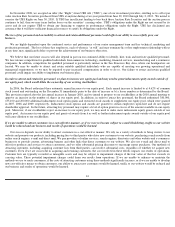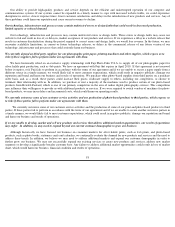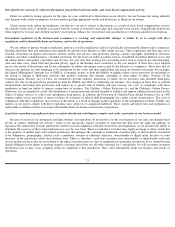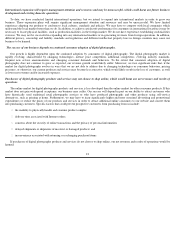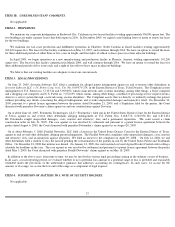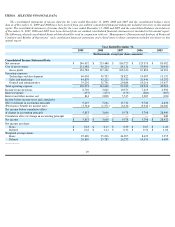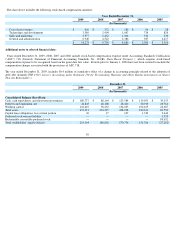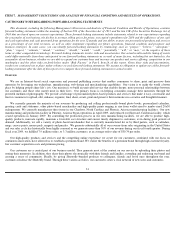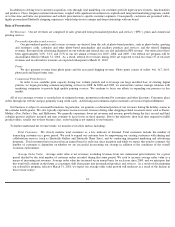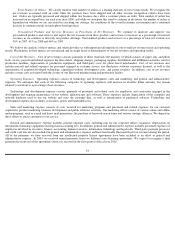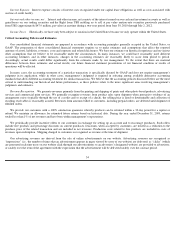Shutterfly 2010 Annual Report Download - page 26
Download and view the complete annual report
Please find page 26 of the 2010 Shutterfly annual report below. You can navigate through the pages in the report by either clicking on the pages listed below, or by using the keyword search tool below to find specific information within the annual report.
The third party software systems that we utilize to assist us in the calculation and reporting of financial data may contain errors that we may
not identify in a timely manner.
We use numerous third party licensed software packages, most notably our equity software and our enterprise resource planning (“ERP”
)
software, which are complex and fully integrated into our financial reporting. Such third party software may contain errors that we may not
identify in a timely manner. If those errors are not identified and addressed timely, our financial reporting may not be in compliance with
generally accepted accounting principles.
For example, since 2006 we have licensed software from a third-
party to automate the administration of our employee equity programs and
calculate our stock-based compensation expense. The third-
party published a technical bulletin that identified a change to its most current
software version to correct computational errors in determining stock-
based compensation expense. In October 2009, we identified that the
version of the software we used to calculate stock-based compensation contained the same error and that we had incorrectly calculated stock-
based compensation expense. We concluded that it was necessary to restate certain previously issued financial statements for errors in the
amount of stock-
based compensation recorded. As a result of identifying the error, we restated our financial statements for the years ended
December 31, 2007 and 2008, to record additional stock-
based compensation expense of approximately $0.7 million in 2007 and $1.1 million in
2008.
If our internal controls are not effective, there may be errors in our financial information that could require a restatement or delay our SEC
filings, and investors may lose confidence in our reported financial information, which could lead to a decline in our stock price.
In October 2009, in connection with the restatement of our financial statements related to our accounting for stock-
based compensation
expense, we determined that we had a material weakness in our internal controls, which pertained to controls to ensure the completeness and
accuracy of stock-
based compensation expense. This weakness resulted in the restatement of our consolidated balance sheets at December 31,
2008 and December 31, 2007, and our consolidated statements of operations, stockholders’
equity and cash flows for the fiscal years ended
December 31, 2008 and December 31, 2007, and the related notes thereto to correct an error in our stock-based compensation expense.
It is possible that we may discover other significant deficiencies or material weaknesses in our internal control over financial reporting in the
future. Any failure to maintain or implement required new or improved controls, or any difficulties we encounter in their implementation, could
cause us to fail to meet our periodic reporting obligations, or result in material misstatements in our financial information. Any such delays or
restatements could cause investors to lose confidence in our reported financial information and lead to a decline in our stock price.
Maintaining and improving our financial controls and the requirements of being a public company may strain our resources, divert
management’s attention and affect our ability to attract and retain qualified board members.
As a public company, we are subject to the reporting requirements of the Securities Exchange Act of 1934, the Sarbanes-
Oxley Act of 2002
and the rules and regulations of The NASDAQ Stock Market. Additional or new regulatory requirements may be adopted in the future. The
requirements of existing and potential future rules and regulations will likely continue to increase our legal, accounting and financial compliance
costs, make some activities more difficult, time-consuming or costly and may also place undue strain on our personnel, systems and resources.
The Sarbanes-
Oxley Act requires, among other things, that we maintain effective disclosure controls and procedures and effective internal
control over financial reporting. Significant resources and management oversight are required to design, document, test, implement and monitor
internal control over relevant processes and to, remediate any deficiencies. As a result, management’
s attention may be diverted from other
business concerns, which could harm our business, financial condition and results of operations. These efforts also involve substantial
accounting related costs. In addition, if we are unable to continue to meet these requirements, we may not be able to remain listed on The
NASDAQ Global Market.
24




